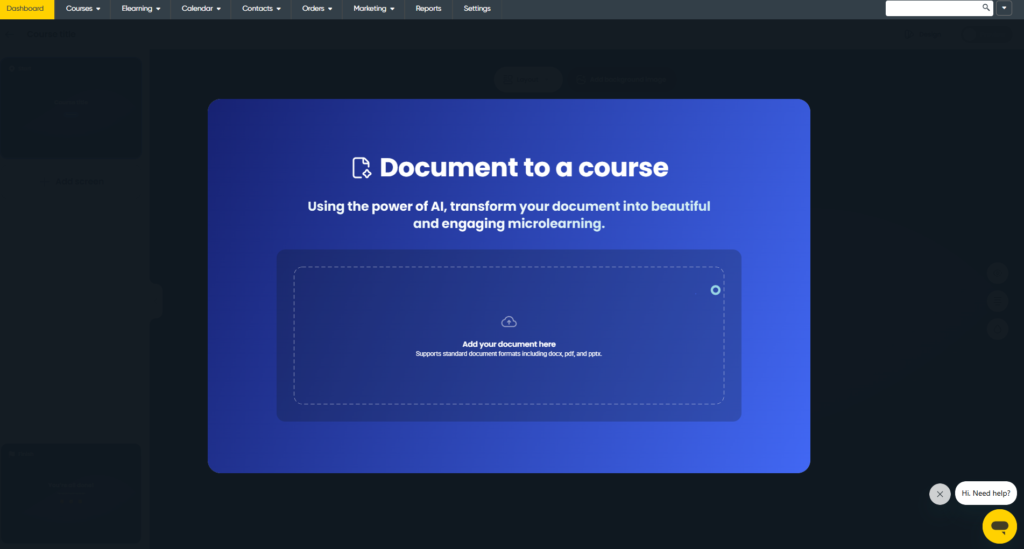Recently updated on April 17th, 2025
The debate between Self Paced Learning vs Instructor Led Learning is often framed as a question of which method is “best.”
However, the real focus should be on which learning method will most effectively help the learner meet the objectives of a course or module.
To determine which approach is right for your learners, it’s important to have a solid understanding of both training methods.
With this understanding, you’ll be better equipped to decide when each method is most appropriate. Looking at examples of training providers who successfully use both methods, and knowing when they choose one over the other, can provide valuable insights.
In this guide, we’ll break down both methods, offer tips on when each is suitable, and provide real-world examples to give you a clearer picture of how to apply these methods effectively.
By the end, you’ll have a strong grasp of both training methods and be able to make informed decisions based on your learners’ needs.
Let’s start with a look at self-paced learning 👇
What is Self-Paced Learning?
The clue is in the name, self-paced learning is an instructional approach that refers to learners navigating educational content at a rate and schedule determined by their individual needs, and its often created through an LMS or an elearning authoring and delivery platform.
Unlike traditional classroom-based learning, where an instructor guides the learning, self paced learning gives learners greater autonomy over their learning process.
Self paced learning also allows for flexible scheduling, the ability for a learner to revisit material as needed, and for the learning provider to adapt the learning experience to personal comprehension, and their own learning journey.
Traditionally self-paced learning existed in forms such as printed materials and recorded lectures. However, it can now be found in a variety of digital formats, including online courses, interactive modules, and virtual classrooms.
Related Read: Types of eLearning: 11 for Training Providers to Try in 2025
What Are Benefits of Self-Paced Learning for Learners?
Flexibility and Accessibility
Learners can access course materials at any time and from any location, taking away geographical barriers barriers, and strict timetables. Stats suggest that in some cases up to 63% of students choose to study online because of the flexibility it offers
Personalized Learning Pace
Learners can progress through content at a speed that suits their learning needs, and style. For example, they can dedicate ore time to challenging topics and move more quickly through familiar ones.
In most LMS and self-paced training platforms an admin or instructor can track learner progress as they make their way through a self paced module or course, an keep track of any drop of points, or areas where learners may need more attention and assistance.
Repetition Can Improve Retention
The ability to revisit materials as needed reinforces learning, can lead to better retention and understanding of the subject matter.
You can also include interactive training elements like quizzes, games, flashcards and more to help your learners retain more material. Research suggest that online learning can increase learner retention rate by as much as 60%.
What Are Benefits of Self-Paced Learning for Training Providers?
Scalability and Resource Efficiency
Self-paced courses can accommodate large numbers of learners. Sometimes in a physical or live online classroom setting numbers can be limited by space, or how many learners the instructor can effectively teach. In a self-paced environment these limits aren’t a concern.
Training providers can also scale the training they offer with self paced courses, particularly if they’ve traditionally just relied on physical or virtual instructor-led training.
Reduced Instructional Costs
With learners engaging with pre-recorded or asynchronous materials, there’s no need for physical venues and the associated costs such as travel, accommodation, learning materials etc.
Insights Into Learner Performance
Training Management Systems & Learning Management Systems (LMS) track learner progress and engagement, providing valuable data that can inform course improvements and identify areas where learners may need additional support.
This can include metrics such as completion rates and quiz scores. If you’re selling self paced courses, through a platform like Arlo you can also measure metrics such as how much revenue a course has brought in, how many learners from a particular organization have signed and much more.
Continuous Content Availability
Self-paced training materials are accessible indefinitely, a creator simply has to create the course, market the course successfully and learners can sign up whenever they please. Course creators can also update the materials within a self paced course whenever they need to.
This has become even easier with the growth in AI tools that can be used for training content creation. For example, within Arlo you can simply drop into head into a self paced course you’ve created and use our AI assistant to help you update training materials.
Or if you wish to transform exiting training materials you have such as a PDF or checklist to form part of a self paced course, simply drop it into Arlo’s ‘Document to a course’ feature and watch your document transform into engaging, accessible elearning content.

What Are the Disadvantages of Self Paced Learning for Learners?
Potential for Misinterpretation or Misunderstanding of Content
Without immediate feedback or clarification from an instructor, learners might misinterpret complex concepts or develop misunderstandings that go uncorrected, which can lead to gaps in knowledge.
There are strategies to mitigate this though, even in a self-paced environment such as:
- Offering pre-reading, or recommended post course reading materials for the learner to discover.
- You could offer a ‘premium’ service where a learner can ask you questions about the material, and you provide an answer
- You can include relatable scenarios throughout the self-paced course such as case studies and common scenarios.
Feeling of Isolation and Lack of Community
Learners in self-paced environments may experience feelings of isolation due to the lack of social interaction and peer support that are present in traditional classrooms.
Although there are plenty of tools available within self-paced training platforms like forums, chat communities and more, it can still be hard to replicate the connections that learners can make with one another face to face.
Difficulty in Staying Focused and Managing Time
It can be tricky for learners to manage their time effectively in a self-paced setting, but you can mitigate this by putting time limits on certain modules within a self-paced course.
For example, you could set a 1-week limit to complete each module, with a reminder sent to the learner when they have 2 days left.
What Are the Disadvantages of Self Paced Learning for Training Providers?
Reduced Revenue Potential (in certain cases)
Self-paced courses can generate less revenue compared to instructor-led training. This can be due to the perceived value of the course, if a course is being taught by an expert in a field a training provider is typically able to charge more than a self-paced course that just contains content.
Completion Rates Can Be a Challenge
Self-paced learning can suffer from low completion rates, with studies showing that only 5% to 15% of learners finish their courses.
There are a few simple steps you can take to improve course completion rates though, such as:
Break content into bite-sized modules – Research shows that many self-paced learners prefer shorter content, with 5-15 minute lessons being an ideal range. Breaking self paced content into chunks can make the content more consumable and manageable.
Send regular progress reminders – se email automation to send reminders about progress, upcoming deadlines, or milestones, with encouraging messages to inspire learners to continue their studies.
Scenarios Best Suited for Self-Paced Learning
Self-paced learning proves most effective when the subject matter is primarily theoretical. In corporate/employee training scenarios, topics such as compliance training and policy updates are common self-paced subjects.
Commercial training providers and companies that sell courses also offer regular self-paced training. Below is an example of a course run by Arlo customer Humentum, who, in the image, are offering ‘Financial Management for Development Professionals’ online in a self-paced format.


What is Instructor-Led Training?
Instructor-led training simply means any form of training taking place being taught by a instructor. This can be in a classroom based setting, outside in a practical environment like a workshop or workplace, or virtually through a platform like Zoom.
Having instructors and learners in the same physical location can create more interactive and engaging training sessions. And there are plenty of topics and industries where instructor led training is a better fit than self paced learning.
For example, many of our customers at Arlo are in the trades, or health and safety where practical instruction facilitated by an experienced practitioner is key.
What Are the Advantages of Instructor-Led Training for Learners?
ILT Offers a More Personalized Learning Experience
Instructor-led training allows for real-time adaptation to learners’ needs. Instructors can adjust the pace of a session, provide additional explanations, incorporate examples and tailor the content based on the group’s understanding of a topic.
Immediate Feedback and Clarification
Learners can ask questions and receive immediate responses from the instructor. If there’s a concept a learner doesn’t understand, the feedback can be much more immediate than they’ll receive in a self-paced course (where they may not receive feedback or clarification at all).
ILT Can Meet Different Learning Styles More Effectively
So long as a trainer plans a session effectively ILT can be tailored to meet the different learning styles participants have. This can be as simple as creating a checklist of the different activities you plan to use in an ILT session, and making sure that you have activities suited for different learning styles.
It could look something like this:
| Activity | Learning Style | Purpose | Notes |
| Icebreaker Activity | Kinesthetic | Build rapport and warm up participants | Use movement or creative thinking tasks |
| Slide Presentation | Visual | Introduce key concepts | Include diagrams, pictures, and minimal text |
| Group Discussion | Auditory | Explore ideas collaboratively | Use open-ended questions to spark dialogue |
| Role-Playing | Kinesthetic | Practice real-life scenarios | Include clear roles and objectives |
| Case Study Analysis | All | Apply theory to practical situations | Provide clear instructions and debrief |
| Wrap-Up Reflection | Auditory, Visual | Summarize learning and gather feedback | Use verbal summaries and a visual checklist |
Want to learn more?
Inside the Ultimate Guide to Instructor-Led Training, we explore what you need to do to deliver effective ILT in 2025.
What Are the Advantages of Instructor-Led Training for Training Providers?
Higher Revenue Potential
As we mentioned earlier, training providers can generally charge more for an instructor-led course. Based on our own data, and what we hear from our customers, demand for ILT continues to grow.
From our internal data, we’ve observed a gradual increase in the amount of face-to-face training our customers are delivering. Specifically, there has been approximately a 10% rise when comparing data from October 2022 to October 2024.
And Arlo customer, and training expert Tammy Banks, has noticed the same trend in her business, Transform Your Training:
“We’re seeing a rise in instructor-led training bookings as more customers recognize its impact on their teams. While eLearning offers many benefits, customers are finding that it often falls short in delivering the results they are looking for, especially for complex topics where strong knowledge retention is required for the training to have an impact.”
Upselling Opportunities
Face-to-face interaction can allow trainers to identify additional training needs and promote other courses or services.
They may find that there are other courses a customer is open to, or if they are delivering training to a company, they may find that the client has members of their team they want to learn how to become trainers themselves, so the company can develop their internal training capabilities.
Client Relationship Building
In-person training can create strong connections between a training provider and their clients. Particularly if the client sees the direct impact the training is having on their team.
What Are the Disadvantages of Instructor-Led Training for Learners:
Fixed Time for the Training or Class to Take Place
Instructor-led training often requires learners to attend a class at a predetermined time which can be challenging for those with busy schedules or conflicting obligations.
Sometimes a Pace Mismatch Can Occur
In a group setting, the instructor must cater to the average pace of the class. This can sometimes lead to some learners feeling rushed through complex topics while others may feel held back.
The Training May Not Meet the Learning Style of the Learner
ILT can meet multiple learning styles, but only if the instructor tailors and plans their course or ILT session properly.
An inexperienced instructor may not do this, resulting in uninspiring and unengaging ILT sessions where the instructor simply lectures learners.
Disadvantages of Instructor-Led Training for Training Providers:
Putting on ILT Can Have High Costs
Instructor-led training can involve expenses such as venue rentals, paying for instructors, travel costs, printing and housing training materials. So you’ll need to budget carefully when you’re running ILT sessions.
Can Be Tricky to Scale
Training providers can only accommodate a limited number of participants at a time, making it challenging to train large groups simultaneously.
There are solutions to this though, many of our customers integrate Arlo with a video platform like Zoom to create and host virtual instructor-led training sessions. Platforms like Zoom (depending on the plan you select) enable you to host hundreds of learners in a single session.
Training Consistency Can Be Tricky
With multiple instructors, it can be difficult to maintain consistent program content, delivery, and quality across different sessions.
However, there are steps you can take to mitigate this. Putting your instructors through certifications, such as Train the Trainer, ensures that their skills have been tested and that they possess the adequate knowledge and expertise to deliver high-quality ILT sessions.
Scenarios Best Suited for Instructor-Led Training
Instructor-led training works best for any topic where practical instruction and hands on learning is required. At Arlo, we work with hundreds of instructor-led training professionals, ranging from companies running in-person and virtual AI training workshops to providers running courses on crane safety.
The thing they all have in common? Their courses are taught by an instructor who provides professional instruction to learners.
You can see a couple of examples below, the first image of a course overview page of All Borough Safety Council who offer safety training programs to construction professionals through New York.
The second is an example of an in-person First Aid course offered by St John New Zealand.



Sometimes Its Best to Take a Blended Approach
As you can see, there’s no one size fits all about whether self-paced learning or instructor-led is ‘better’.
Generally speaking, self-paced learning is better suited for theoretical knowledge, while instructor-led training is more effective for practical skills, where learners benefit from hands-on guidance, and immediate feedback.
Often integrating both into a course is necessary, also known as taking a blended learning approach. You may have topics that require in-person tuition, and some that can be taught effectively through online, self-paced modules.
The most important thing to remember is to prioritize the method that will help your learners achieve their objectives in the most effective way possible.